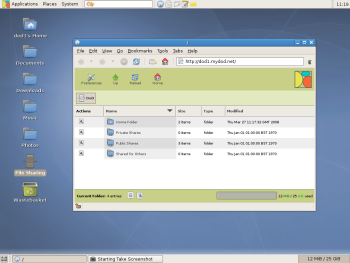Author: Dmitri Popov
Desktop on Demand (DOD) is the latest contender to give users a full-fledged remote desktop instead of Web-based applications to help users to stay productive when they are on the move. Similar to Ulteo (which we reviewed not long ago), DOD gives you a full-blown remote Linux-based desktop — but that’s where the similarity ends. Unlike Ulteo, which is based on the VNC protocol and runs entirely in the browser using a Java-based applet, DOD employs the NoMachine NX technology for accessing the remote desktop.
To connect to your DOD desktop you have to use dedicated client software, which is available for Linux, Mac OS X, and Windows at DOD’s Web site, and requires no installation. This means that you can copy the software to a USB stick and run it on any computer. Although this approach may not seem as straightforward as using a browser, it offers a few important advantages. For starters, the NX protocol makes better use of the available bandwidth than VNC, which results in a more responsive desktop and better display quality. The client also allows you to create multiple profiles for use in different situations. For example, you could create one profile for your desktop computer, which uses a fast connection and has a big screen, and another for use on your laptop, which has a smaller screen and uses a modem connection. To create a new profile, launch the Desktop on Demand client and press the Configure button. In the Settings dialog window you can configure different settings for a new session, including connection type, the desired screen resolution, and compression type.
The DOD desktop is based on GNOME and offers a set of applications that cover all the basics, including Web browsing (Mozilla Firefox and Epiphany), email and calendaring (Evolution), instant messaging (Pidgin), word processing (OpenOffice.org and AbiWord), and image manipulation (the GIMP). Unfortunately, this decent bundle uses older versions of the key applications, such as Firefox 1.5.0.12, OpenOffice.org 2.0, and the GIMP 2.2. This can be a deal-breaker if you can’t live without some Firefox or OpenOffice.org extensions, or just want to take advantage of the features available in the latest versions of the applications.
Although the remote desktop is stripped of all the system configuration tools, it does include a few control panels, which you can use to adjust the desktop to your needs. Unfortunately, not all of them work as they are supposed to. I’m a left-hander and use a Danish keyboard, and I tried without luck to adjust the mouse settings and switch the keyboard layout. Enabling the Left-handed mouse option in the Mouse control panel didn’t have any effect, while adding the Danish keyboard layout resulted in an X.Org-related error. Although this might not be DOD’s fault, the inability to switch to a different keyboard layout limits DOD’s usefulness for international users.
When it comes to moving files and documents to and from your remote desktop, DOD offers two options. The service comes with an integrated Web-based file manager, which you can access using your browser. In other words, you don’t have to use the NX client to download and upload documents and files. DOD also supports the WebDAV protocol, which allows you to mount and treat your DOD disk as a local folder.
DOD makes it easy to share files stored on your remote desktop with other DOD users. All you have to do is add the desired users to your account and enable sharing for individual files and documents.
DOD offers several subscription plans as well as a free 28-day trial. The cheapest plan at £4 (about $8) comes with 5GB of storage space, but it doesn’t include Firefox and OpenOffice.org and it also lacks the ability to install plugins and third-party applications. The most expensive plan at £15 (about $30) gives you 100GB of storage space and the missing applications.
Desktop on Demand is a neat solution for those who like the idea of having a full-blown Linux desktop at their disposal anywhere they go, but its use of dated versions of the key applications is disappointing. Also, keep in mind that while DOD markets itself as an ideal solution for storing files and documents, Amazon S3-based services such as Jungle Disk offer much cheaper flexible solutions for that purpose.
Categories:
- Reviews
- Internet & WWW



